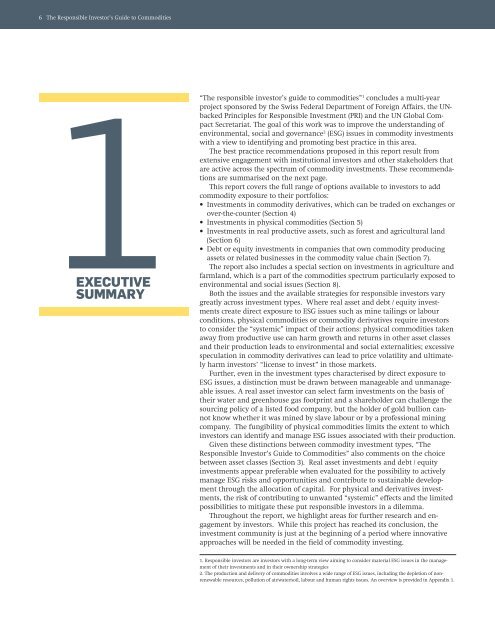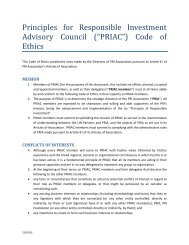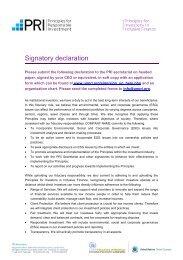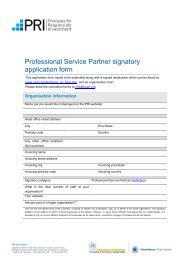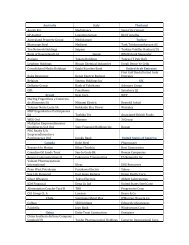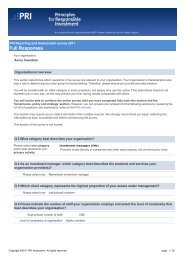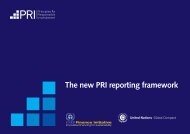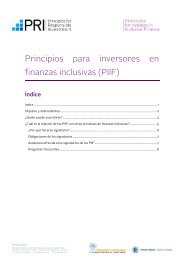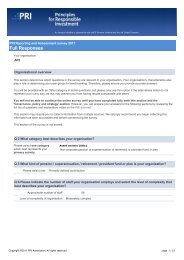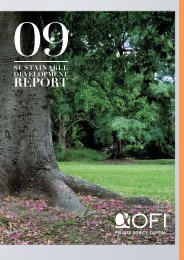investor's guide to commodities - PRI Signatory Extranet - Principles ...
investor's guide to commodities - PRI Signatory Extranet - Principles ...
investor's guide to commodities - PRI Signatory Extranet - Principles ...
- No tags were found...
You also want an ePaper? Increase the reach of your titles
YUMPU automatically turns print PDFs into web optimized ePapers that Google loves.
6 The Responsible Inves<strong>to</strong>r’s Guide <strong>to</strong> Commodities1EXECUTIVESUMMARY“The responsible inves<strong>to</strong>r’s <strong>guide</strong> <strong>to</strong> <strong>commodities</strong>” 1 concludes a multi-yearproject sponsored by the Swiss Federal Department of Foreign Affairs, the UNbacked<strong>Principles</strong> for Responsible Investment (<strong>PRI</strong>) and the UN Global CompactSecretariat. The goal of this work was <strong>to</strong> improve the understanding ofenvironmental, social and governance 2 (ESG) issues in commodity investmentswith a view <strong>to</strong> identifying and promoting best practice in this area.The best practice recommendations proposed in this report result fromextensive engagement with institutional inves<strong>to</strong>rs and other stakeholders thatare active across the spectrum of commodity investments. These recommendationsare summarised on the next page.This report covers the full range of options available <strong>to</strong> inves<strong>to</strong>rs <strong>to</strong> addcommodity exposure <strong>to</strong> their portfolios:• Investments in commodity derivatives, which can be traded on exchanges orover-the-counter (Section 4)• Investments in physical <strong>commodities</strong> (Section 5)• Investments in real productive assets, such as forest and agricultural land(Section 6)• Debt or equity investments in companies that own commodity producingassets or related businesses in the commodity value chain (Section 7).The report also includes a special section on investments in agriculture andfarmland, which is a part of the <strong>commodities</strong> spectrum particularly exposed <strong>to</strong>environmental and social issues (Section 8).Both the issues and the available strategies for responsible inves<strong>to</strong>rs varygreatly across investment types. Where real asset and debt / equity investmentscreate direct exposure <strong>to</strong> ESG issues such as mine tailings or labourconditions, physical <strong>commodities</strong> or commodity derivatives require inves<strong>to</strong>rs<strong>to</strong> consider the “systemic” impact of their actions: physical <strong>commodities</strong> takenaway from productive use can harm growth and returns in other asset classesand their production leads <strong>to</strong> environmental and social externalities; excessivespeculation in commodity derivatives can lead <strong>to</strong> price volatility and ultimatelyharm inves<strong>to</strong>rs’ “license <strong>to</strong> invest” in those markets.Further, even in the investment types characterised by direct exposure <strong>to</strong>ESG issues, a distinction must be drawn between manageable and unmanageableissues. A real asset inves<strong>to</strong>r can select farm investments on the basis oftheir water and greenhouse gas footprint and a shareholder can challenge thesourcing policy of a listed food company, but the holder of gold bullion cannotknow whether it was mined by slave labour or by a professional miningcompany. The fungibility of physical <strong>commodities</strong> limits the extent <strong>to</strong> whichinves<strong>to</strong>rs can identify and manage ESG issues associated with their production.Given these distinctions between commodity investment types, “TheResponsible Inves<strong>to</strong>r’s Guide <strong>to</strong> Commodities” also comments on the choicebetween asset classes (Section 3). Real asset investments and debt / equityinvestments appear preferable when evaluated for the possibility <strong>to</strong> activelymanage ESG risks and opportunities and contribute <strong>to</strong> sustainable developmentthrough the allocation of capital. For physical and derivatives investments,the risk of contributing <strong>to</strong> unwanted “systemic” effects and the limitedpossibilities <strong>to</strong> mitigate these put responsible inves<strong>to</strong>rs in a dilemma.Throughout the report, we highlight areas for further research and engagementby inves<strong>to</strong>rs. While this project has reached its conclusion, theinvestment community is just at the beginning of a period where innovativeapproaches will be needed in the field of commodity investing.1. Responsible inves<strong>to</strong>rs are inves<strong>to</strong>rs with a long-term view aiming <strong>to</strong> consider material ESG issues in the managemen<strong>to</strong>f their investments and in their ownership strategies2. The production and delivery of <strong>commodities</strong> involves a wide range of ESG issues, including the depletion of nonrenewableresources, pollution of air/water/soil, labour and human rights issues. An overview is provided in Appendix 1.


